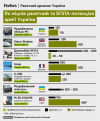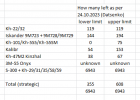https://forbes.ua/war-in-ukraine/raketi-30102023-16966
Category
War
Date October 30, 5:55 p.m
Russia spent $22.8 billion on missile strikes against Ukraine and continues to increase their production. What to expect from the enemy this winter? Forbes estimates
Volodymyr Datsenko
Forbes
Ukraine was actively preparing its energy network for the new winter period. Instead, Russia increased the production of missiles and drones. How serious is the threat of missile strikes this winter - in the analysis of Forbes.
Last year, the Ukrainian air defense was just beginning to master the first samples of the Western air defense systems
Iris-t and
NASAMS , which were handed over to us by the allies. The main air defense system of the US Army, Patriot , which the Armed Forces of Ukraine
received only in March 2023 , was only to be dreamed of, and the threat of
a complete blackout loomed over the country .
Last year, Ukraine managed to resist Russian attacks
thanks to the colossal efforts of Ukrainian energy workers and
operators of air defense systems . Now, Ukrainian citizens and businesses have managed to get used to systematic blackouts. Ukraine has significantly
increased the effectiveness of interception of air targets launched by Russia.
But the missile threat from the Russian Federation has still not gone anywhere.
The enemy was actively preparing , increasing the pace of production and improving the tactics of missile attacks.
How many missiles and drones does Russia make?
If we analyze
the data of the Ministry of Defense of Ukraine regarding the stocks and production of Russian missiles in January 2023, in the first year of the great war, Russia produced an average of about 50-60 long-range missiles per month.
According to the latest
estimates of the General Staff of the Armed Forces of Ukraine, Russia has increased production in 2023 to 100 missiles per month. In addition, the Russians have about 120 old Soviet Kh-22 missiles and hundreds of shorter-range Kh-59, Kh-31, S-300, etc. missiles.
Russia increased the production and use of Shahed-136 attack UAVs even more. Only in September-October 2023, according
to the Air Force Command of Ukraine, the Russian Federation used 865 kamikaze drones for airstrikes. Compared to 2022, the intensity of use of Shahed-136 has increased six times.
Despite the fact that about 80% of these drones are shot down by the Air Defense Forces of Ukraine, their number still constitutes a significant threat. Only in the last two months, 151 "shahed" were able to fly to the target. Which led to the destruction
of grain terminals and
civilian objects .

The Novaya Poshta terminal in Kharkiv Oblast after a missile attack by the Russian army on the evening of October 21. Six people died.
Photo by the press service of Novaya Poshta
How much does Russia spend on missile strikes?
According to Forbes estimates, as of October 2023, Russia has launched more than 3,000 missiles at Ukraine, spending $22.8 billion on missile strikes. This is equal to the cost of almost half of all
US military aid to Ukraine since February 24, 2022.
Despite the fact that the majority of air attacks in recent months have been carried out without the use of missiles, but exclusively by UAVs, by October, Russia was still expending about 100 missiles per month. But over the past month, Russian forces have used only 31 missiles.
The last mass missile attack of Ukraine
took place on September 21, 2023 . Then, in one day, Russia launched 43 cruise missiles over Ukraine. Such savings indicate that the enemy is trying to accumulate a certain stock of missiles for future winter attacks.
Despite the incredibly high cost of missile attacks for Russia - about $0.5-1 billion per month - the enemy is unlikely to abandon the tactics of missile terror before the end of the war, even if such attacks do not cause significant military or even economic damage.
So the winter months will be another test for the Ukrainian air defense system.
How effective is Ukrainian air defense
Over the past year, Ukrainian air defense has made a hyper-leap in the quality and efficiency of its work. If in September 2022 the Air Defense Forces of Ukraine
shot down about 20-30% of missiles, then in April-July 2023 - about 80-90%.

How many missiles have been launched by the Russian army over Ukraine since February 2022, what is their cost, and what is the effectiveness of Ukrainian air defense
Photo infographic Forbes Ukraine
But these numbers hide certain nuances. The Western Patriot and
SAMP-T systems managed to cover only the most important directions of potential attacks, but not the entire sky over Ukraine.
If air defense over Kyiv region intercepts almost all cruise and ballistic missiles, even
hypersonic "Daggers" , in most cases of strikes on other regions of the country, ballistic missiles still remain an almost elusive target. When the focus of Russian missile attacks shifted to the south in the fall, the percentage of interceptions dropped to 50-60% of destroyed missiles.
Russia is also improving its missile strike tactics, using different types of missiles, including combining cruise and ballistic missile attacks and using stealthy Onyx missiles .
In addition to anti-aircraft defense, an important priority of the Ukrainian government has become the program of engineering protection of energy facilities. In particular
, UAH 9.74 billion was allocated to energy infrastructure shelters from the Fund for Elimination of the Consequences of Armed Aggression.
So, potentially, the Ukrainian energy infrastructure should be much more protected than last year. But we will be able to see how effective these measures will be already this winter.

A residential building in Zaporizhia, hit by a Russian missile on October 18, 2023. Two people died, three were injured, and about 50 residents of the building were evacuated.
Photo by Getty Images
Ukraine has something to answer for
The main change that has taken place is not even the strengthening of Ukrainian air defense and the sheltering of energy infrastructure facilities, but the appearance in Ukraine of opportunities for strikes on Russian military facilities deep in the Ukrainian territory controlled by the enemy.
President Volodymyr Zelenskyy
reported that the authorities are preparing for enemy strikes on the energy infrastructure. "This year we will not only defend ourselves, but also respond," he said.
First, it is the appearance of a whole line of long-range kamikaze drones (from 200 to 500 km). And although they do not have a great destructive effect due to the small weight of the charge, they are still capable of hitting open objects. Such as oil depots, ammunition depots, air defense complexes, etc.
Ukrainian forces use them not only on the occupied territory, but also on the territory in the depths of the Russian Federation.
Also, long-range
Storm Shadow and
Scalp missiles were transferred to Ukraine from Great Britain and France . It was possible to convert Soviet Su-24 bombers for their use. It is likely that there is an agreement on their non-application on the territory of the Russian Federation.

How the missile and UAV potential of the Ukrainian army strengthened
DCKB "Luch" and its co-executors were also able to start production of modified versions of "Vilkha" and
"Neptun" missiles , which positively proved themselves in the first months of the great war.
In particular , a new version of the Neptune missile was produced for strikes against ground targets. It was this missile
that destroyed the newest Russian air defense complex S-400 "Triumph" . And this is proof of the effectiveness of the Ukrainian missile, because the S-400 is designed to intercept precisely such missiles. Probably, Ukrainian manufacturers are able to produce a limited number of them, but there is also no restriction on their use on the territory of the Russian Federation.
Ukrainian forces also
began using modified S-200 missiles to
strike ground targets . Previously, they were used only by the Russian side for strikes on Ukraine.
The latest update of the Ukrainian missile arsenal is American
M39 ATACMS cluster missiles with a range of 165 km. It is a heavy missile capable of striking over a large area and destroying a large number of defenseless targets at once.
According to
Forbes estimates, as a result of the first use of ATACMS by the Ukrainian military at airfields near occupied Berdyansk and Luhansk, $341 million worth of Russian equipment was destroyed.
Considering this, the new company of strikes on the energy system of Ukraine will contain significant risks for Russia, because this time Ukraine has something to answer for.












